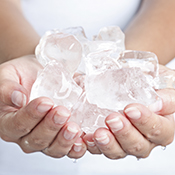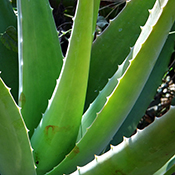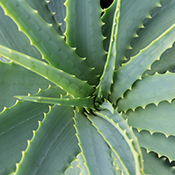Other Burns of Summer
Frequently Asked Questions
How do I tell the difference between a first-degree burn from a second-degree burn?
First-degree symptoms include pain, redness, swelling, increased sensitivity and dryness. Second-degree burns not only have all the symptoms of first degree burns but also develop painful blisters. If a second-degree burn is larger than 3 inches or covers the hands, legs or groin areas, seek medical attention immediately.
How do I treat minor burns?
Minor first-degree and many second-degree burns can be treated quickly and effectively in the home if you follow these four simple steps:
- Run your burned skin under cool, running water until the heat of the burn has dissipated or for 10 to 15 minutes. Not only will the running water help cool your burn, it will also remove any debris or irritants that could prevent your burn from healing properly. Let your skin dry. Under no circumstances should you apply ice to any burn.
- When dry, apply ALOCANE® Maximum Strength Emergency Burn Gel to the affected area. Do not use ALOCANE® on raw skin or blisters.
- Gently apply a loose, sterile bandage to protect your skin from further irritation, which would delay healing. Be sure to change the bandage as needed.
- Re-apply ALOCANE® Maximum Strength Emergency Burn Gel as needed but no more than three to four times daily.
It may be tempting, but you should resist the urge to pop any blisters that have formed. Popping blisters makes it more likely for you to get an infection at the burn site, which will greatly hinder the healing process. Avoid using any home remedies like honey, butter, mayo or oil. These home remedies may not be sterile and may cause your burn to become infected. Most minor first-degree burns typically heal within 5 to 10 days. Second-degree burns, however, can take up two to three weeks to fully heal. Actual recovery time for your burn will vary depending on the location and severity of the burn site.
How long until my burn heals?
Most minor burns, like sunburns, will heal within 5 to 10 days. Second-degree burns can take 2 to 3 weeks. Recovery time varies and depends on the location of the injury and the severity of the burn. Use ALOCANE® Maximum Strength Emergency Burn Gel to expedite the healing process.
Why do burns scar?
As your burn heals, your skin resumes producing collagen, a tissue that can thicken, tighten and develop into a scar. ALOCANE® Scar Prevention Therapy Gel is a direct defense against scar formation.
How can I avoid making my burn worse?

Under no circumstances should you apply ice to any burn. Do not peel your skin and do not pop any blisters. Think twice about applying popular home remedies like honey, butter or oil as they may not be sterile and could cause an infection.
For a more detailed information on ALOCANE® Maximum Strength Emergency Burn Gel versus home remedies, click here.
How do I treat sunburn?

Although sunburns are extremely common, it is important to take your pain and peeling seriously. Drink plenty of water to stay hydrated and keep your burned skin out of the sun. Take a cool shower (do not use soap or body wash) and apply ALOCANE® Maximum Strength Emergency Burn Gel to small sensitive spots like your face and hands for pain relief and to promote healing. Do not use more than directed. If your sunburn covers larger areas of your body, find a product containing Aloe vera more suited for slathering. Cover your sunburn until it has healed.
Do home remedies work?

Although many home remedies soothe the initial burn, they do not treat pain and can even make your burn worse. Lemon juice, mayo, butter, oil and ice are all popular home remedies that may lead to infection and other complications if used on damaged and susceptible skin. For a more detailed information on ALOCANE® Maximum Strength Emergency Burn Gel versus home remedies, click here.
Can I use ALOCANE® Maximum Strength Emergency Burn Gel on an insect bite?
Yes, ALOCANE® Maximum Strength Emergency Burn Gel will treat the pain and itching associated insect bites or stings and minor skin irritations.
Can I use ALOCANE® Maximum Strength Emergency Burn Gel on itchy skin?
Yes, ALOCANE® Maximum Strength Emergency Burn Gel can also be used to treat pain and itching from poison ivy, poison oak and other skin irritations.
Why only 4% lidocaine?
4% Lidocaine is the maximum percentage approved by the FDA.
What's so special about aloe vera?

Aloe vera, also known as Aloe Barbadensis, contains natural antibacterial compounds and can help new skin cells form, which accelerates the healing process.
Is there aloe in ALOCANE®?

Yes, even though a recent study exposed that many aloe-based products on the market contain little or no aloe both ALOCANE® Maximum Strength Emergency Burn Gel and ALOCANE® Scar Prevention Therapy Gel contain Aloe.
Can I get Lidocaine poisoning from ALOCANE®?
ALOCANE® Maximum Strength Emergency Burn Gel contains 4% Lidocaine, the maximum percentage approved by the FDA. Use as directed.
What is onion bulb extract?
Known for its anti-inflammatory properties, onion bulb extract is derived from natural onion flesh and is an ingredient in ALOCANE® Advanced Scar Therapy Gel.
Does ALOCANE® Maximum Strength Emergency Burn Gel expire?
Yes, it does expire. Be sure to replace your bottle if its expiration date has passed.
Can I use Alocane on a tattoo?
Yes. ALOCANE® Maximum Strength Emergency Burn Gel provides fast and effective relief for pain caused by getting a tattoo.
Can I use Alocane on my face?
Yes. ALOCANE® Maximum Strength Emergency Burn Gel can be carefully applied to the affected areas of the face, avoiding the mouth and eyes.
Is Alocane good for sunburn pain?
Yes. ALOCANE® Maximum Strength Emergency Burn Gel provides fast and effective relief from sunburns.
What are the ingredients used in Alocane?
The primary active ingredient used in Alocane is Lidocaine HCL 4%. The inactive ingredients used in Alocane are 1,3-Propanediol, Aloe Barbadensis (Aloe) Leaf Juice, Dimethyl Isosorbide, Hydroxyethel Cellulose, Phenoxyethanol, Chlorphenesin, Caprylyl Glycol, Tocopheryl Acetate (Vitamin E), and water.

